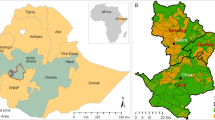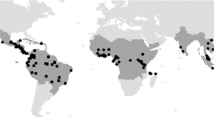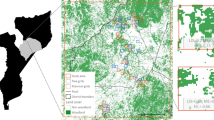Abstract
Latin American subtropical dry ecosystems have experienced significant human impact for more than a century, mainly in the form of extensive livestock grazing, forest products extraction, and agriculture expansion. We assessed the regional-scale effect of land use and land cover (LULC) on patterns of richness distribution of trees, birds, amphibians, and mammals in the Northern Argentine Dry Chaco (NADC) over c. 19 million hectares. Using species distribution models in a hierarchical framework, we modeled the distributions of 138 species. First, we trained the models for the entire Argentinean Chaco with climatic and topographic variables. Second, we modeled the same species for the NADC including the biophysical variables identified as relevant in the first step plus four LULC-related variables: woody biomass, distance to crops, density of livestock-based rural settlements (puestos), and vegetation cover. Third, we constructed species richness maps by adding the models of individual species and considering two situations, with and without LULC variables. Four, richness maps were used for assessing differences when LULC variables are added and for determining the main drivers of current patterns of species richness. We found a marked decrease in species richness of the four groups as a consequence of inclusion of LULC variables in distribution models. The main factors associated with current richness distribution patterns (both negatively) were woody biomass and density of livestock puestos. Species richness in present-day Semiarid Chaco landscapes is strongly affected by LULC patterns, even in areas not transformed to agriculture. Regional-scale biodiversity planning should consider open habitats such as grasslands and savannas in addition to woodlands.







Similar content being viewed by others
References
Adámoli J, Neumann R, Ratier de Colina A, Morillo J (1972) El Chaco aluvional Salteño. Rev Investig Agropecu 9:165–238
Adámoli J, Sennhauser E, Acero JM, Rescia A (1990) Stress and disturbance: vegetation dynamics in the dry Chaco region of Argentina. J Biogeogr 17:491–500
Aide TM, Clark ML, Grau HR, López-Carr D, Levy MA, Redo D, Bonilla-Moheno M, Riner G, Andrade-Núñez MJ, Muñiz M (2013) Deforestation and reforestation of Latin America and the Caribbean (2001–2010). Biotropica 45:262–271
Altrichter M, Boaglio GI (2004) Distribution and relative abundance of peccaries in the Argentine Chaco: associations with human factors. Biol Conserv 116:217–225
Altrichter M, Boaglio G, Perovic P (2006) The decline of jaguars Panthera onca in the Argentine Chaco. Oryx 40:302–309
Anadón JD, Giménez A, Martínez M, Palazón JA, Esteve MA (2006) Habitat selection of the spur-thighed tortoise in a multi-succesional landscape: implications for habitat management. Biodivers Conserv 15:2287–2299
Anadón JD, Giménez A, Martínez M, Palazón JA, Esteve MA (2007) Assessing changes in habitat quality due to land use changes in the spur-thighed tortoise Testudo graeca using hierarchical predictive habitat models. Divers Distrib 13:324–331
Baldi G, Jobbágy EG (2012) Land use in the dry subtropics: vegetation composition and production across contrasting human contexts. J Arid Environ 76:115–127
Brook BW, Sodhi NS, Bradshaw CJA (2008) Synergies among extinction drivers under global change. Trends Ecol Evol 23:453–460
Bucher EH, Huszar PC (1999) Sustainable management of the Gran Chaco of South America: ecological promise and economics constrains. J Environ Manag 57:99–108
Bucher EH, Gavier Pizarro G, Curto ED (2006) Síntesis geográfica. In: Bucher EH (ed) Bañados del río Dulce y laguna Mar Chiquita (Córdoba, Argentina). Academia Nacional de Ciencias, Córdoba, pp 15–27
Cabrera AL (1976) Regiones Fitogeográficas de Argentina. ACME, Buenos Aires
Ceballos G, Ehrlich PR (2002) Mammal population losses and the extinction Crisis. Science 296:904–907
Cei JM (1980) Amphibians of Argentina. Monit Zool Ital Monogr 2:1–609
Collingham YC, Wadsworth RA, Huntley B, Hulme PE (2000) Predicting the spatial distribution of non-indigenous riparian weeds: issues of spatial scale and extent. J Appl Ecol 37:13–27
Colwell RK (2006) EstimateS: statistical estimation of species richness and shared species from samples. http://viceroy.eeb.uconn.edu/estimates
Cushman SA, McGarigal K, Neel MC (2008) Parsimony in landscape metrics: strength, universality, and consistency. Ecol Indic 8:691–703
Dallimer M, Rouquette JR, Skinner AMJ, Armsworth PR, Maltby LM, Warren PH, Gaston KJ (2012) Contrasting patterns in species richness of birds, butterflies and plants along riparian corridors in an urban landscape. Divers Distrib 18:742–753
Dinerstein E, Olson DM, Graham DJ, Webster AL, Primm SA, Bookbinder MP, Ledec G (1995) A conservation assessment of the terrestrial ecoregions of Latin America and the Caribbean. The World Wildlife Fund and The World Bank, Washington, DC
Egoh B, Reyers B, Rouget M, Bode M, Richardson DM (2009) Spatial congruence between biodiversity and ecosystem services in South Africa. Biol Conserv 142:553–562
Eva HD, Belward AS, De Miranda EE, Di Bella CM, Gond V, Huber O, Jones S, Sgrenzaroli M, Fritz S (2004) A land cover map of South America. Glob Chang Biol 10:1–14
Faggi AM, Krellenberg K, Castro R, Arriaga M, Endlicher W (2006) Biodiversity in the Argentinean rolling pampa ecoregion: changes caused by agriculture and urbanization. Erdkunde 60:127–138
Ficetola GF, Maiorano L, Falcucci A, Dendoncker N, Boitani L, Padoa-Schioppa E, Miaud C, Thuiller W (2010) Knowing the past to predict the future: land-use change and the distribution of invasive bullfrogs. Global Chang Biol 16:528–537
Foley JA, DeFries R, Asner GP, Barford C, Bonan G, Carpenter SR, Chapin FS, Coe MT, Daily GC, Gibbs HK, Helkowski JH, Holloway T, Howard EA, Kucharik CJ, Monfreda C, Patz JA, Prentice IC, Ramankutty N, Zinder PK (2005) Global consequences of land use. Science 309:570–574
Gasparri NI, Grau HR, Gutiérrez Angonese J (2013) Linkages between soybean and neotropical deforestation: coupling and transient decoupling dynamics in a multi-decadal analysis. Global Environ Chang 23:1605–1614
Giménez AM, Hernández P, Figueroa ME, Barrionuevo I (2011) Diversidad del estrato arbóreo en los bosques del Chaco Semiárido. Quebracho 19:24–37
Grau HR, Gasparri NI, Aide TM (2005) Agriculture expansion and deforestation in seasonally dry forests of north-west Argentina. Environ Conserv 32:140–148
Grau HR, Gasparri NI, Aide TM (2008) Balancing food production and nature conservation in the Neotropical dry forests of northern Argentina. Global Chang Biol 14:985–997
Hawkins BA, Pausas JG (2004) Does plant richness influence animal richness? The mammals of Catalonia (NE Spain). Divers Distrib 10:247–252
Hoekstra JM, Boucher TM, Ricketts TH, Roberts C (2005) Confronting a biome crisis: global disparities of habitat loss and protection. Ecol Lett 8:23–29
Iriondo MH, García NO (1993) Climatic variations in the Argentine plains during the last 18,000 years. Palaeogeogr Palaeocl 101:209–220
Kacoliris FP, Berkunsky I, Williams J (2006) Herpetofauna of the Argentinean Impenetrable Great Chaco. Phyllomedusa 5:149–157
Kessler M, Abrahamczyk S, Bos M, Buchori D, Dwiputra D, Gradstein SR, Höhn P, Kluge J, Orend F, Pitopang R, Saleh S, Schulze CH, Sporn SG, Steffan-Dewenter I, Tjitrosoedirdjo SS, Tscharntke T (2009) Alpha and beta diversity of plants and animals along a tropical land-use gradient. Ecol Appl 19:2142–2156
Kissling WD, Field R, Böhning-Gaese K (2008) Spatial patterns of woody plant and bird diversity: functional relationships or environmental effects? Global Ecol Biogeogr 17:327–339
Latimer AM, Wu S, Gelfand AE, Silander JA (2006) Building statistical models to analyze species distributions. Ecol Appl 16:33–50
Lawton JH, Bignell DE, Bolton B, Bloemers GE, Eggleton P, Hammond PM, Hodda M, Holt RD, Larsen TB, Mawdsley NA, Stork NE, Srivastava DS, Watt AD (1998) Biodiversity inventories, indicator taxa and effects of habitat modification in tropical forest. Nature 391:72–76
Macchi L, Grau HR (2012) Piospheres in the dry Chaco. Contrasting effects of livestock puestos on forest vegetation and bird communities. J Arid Environ 87:176–187
Macchi L, Grau HR, Zelaya P, Marinaro S (2013) Trade-offs between land use intensity and avian biodiversity in the dry Chaco of Argentina. A tale of two gradients. Agric Ecosyst Environ 174:11–20
Mastrángelo ME, Gavin MC (2012) Trade-offs between cattle production and bird conservation in an agricultural frontier of the Gran Chaco of Argentina. Conserv Biol 26:1040–1051
May JH, Argollo J, Veit H (2008) Holocene landscape evolution along the Andean piedmont, Bolivian Chaco. Palaeogeogr Palaeocl 260:505–520
McGarigal K, Cushman SA, Neel MC, Ene E (2002) FRAGSTATS v3: Spatial pattern analysis program for categorical maps. Computer software program produced by the authors at the University of Massachusetts, Amherst
Minetti JL (1999) Atlas Climático del Noroeste Argentino. Laboratorio Climatológico Sudamericano, Fundación Zon Caldenius, Tucumán
Minetti JL, Vargas WM (1999) Trends and jumps in the annual precipitation in South America, south of the 15°S. Atmosfera 11:205–221
Morello J, Saravia Toledo C (1959a) El bosque chaqueño I. Paisaje primitivo, paisaje natural y paisaje cultural en el oriente de Salta. Rev Agron Noroeste Argent 3:5–81
Morello J, Saravia Toledo C (1959b) El bosque chaqueño II. La ganadería y el bosque en el oriente de Salta. Paisaje primitivo, paisaje natural y paisaje cultural en el oriente de Salta. Rev Agron Noroeste Argent 3:209–258
Neu CW, Byers CR, Peek JM (1974) A technique for the analysis of utilization-availability data. J Wildlife Manag 38:541–545
Pearson RG, Dawson TP (2003) Predicting the impacts of climate change on the distribution of species: are bioclimate envelope models useful? Global Ecol Biogeogr 12:361–371
Pearson RG, Dawson TP, Berry PM, Harrison PA (2002) SPECIES: a spatial evaluation of climate impact on the envelope of species. Ecol Model 154:289–300
Pearson RG, Dawson TP, Liu C (2004) Modeling species distribution in Britain: a hierarchical integration of climate and land-cover data. Ecography 27:285–289
Pineda E, Lobo JM (2009) Assessing the accuracy of species distribution models to predict amphibian species richness patterns. J Anim Ecol 78:182–190
Portillo-Quintero CA, Sánchez-Azofeifa GA (2010) Extent and conservation of tropical dry forests in the Americas. Biol Conserv 143:144–155
Prado D (1993) What is the Gran Chaco vegetation in South America? I. A review. Contribution to the study of the flora and vegetation of the Chaco. V. Candollea 48:145–172
Qian H, Ricklefs RE (2008) Global concordance in diversity patterns of vascular plants and terrestrial vertebrates. Ecol Lett 11:547–553
Ramjohn IA, Murphy PG, Burton TM, Lugo AE (2012) Survival and rebound of Antillean dry forests: role of forest fragments. Forest Ecol Manag 284:124–132
Ratliff RD (1993) Viewpoint: trend assessment by similarity—a demonstration. J Range Manag 46:139–141
Sala OE, Chapin FS, Armesto JJ, Berlow E, Bloomfield J, Dirzo R, Huber-Sanwald E, Huenneke LF, Jackson RB, Kinzig A, Leemans R, Lodge DM, Mooney HA, Oesterheld M, Poff NL, Sykes MT, Walker BH, Walker M, Wall DH (2000) Global biodiversity scenarios for the year 2100. Science 287:1770–1774
Sala OE, van Vuuren D, Pereira HM, Lodge D, Alder J, Cumming G, Dobson A, Wolters V, Xenopoulos MA (2005) Biodiversity across scenarios. In: Carpenter SR, Pingali PL, Bennet EM et al (eds) Ecosystems and human well-being, vol 2., ScenariosIsland Press, Washington, DC, pp 375–408
SAyDS (2004) Atlas de los Bosques Nativos Argentinos. Secretaría de Ambiente y Desarrollo Sustentable, Buenos Aires
Schlinder S, von Wehrden H, Poirazidis K, Wrbka T, Kati V (2013) Multiscale performance of landscape metrics as indicators of species richness of plants, insects and vertebrates. Ecol Indic 31:41–48
Schulze CH, Waltert M, Kessler PJA, Pitopang R, Shahabuddin P, Veddeler D, Mühlenberg M, Gradstein SR, Leuschner C, Steffan-Dewenter I, Tscharntke T (2004) Biodiversity indicator groups of tropical land-use systems: comparing plants, birds, and insects. Ecol Appl 14:1321–1333
Seoane J, Justribó JH, García F, Retamar J, Rabadán C, Atienza JC (2006) Habitat-suitability modeling to assess the effects of land-use changes on Dupont’s lark Chersophilus duponti: a case study in the Layna Important Bird Area. Biol Conserv 128:67–78
Short L (1975) A zoogeographic analysis of the South American Chaco avifauna. B Am Mus Nat Hist 154:163–352
The Nature Conservancy, Fundación Vida Silvestre Argentina, Fundación para el Desarrollo Sustentable del Chaco, Wildife Conservation Society Bolivia (2005) Gran Chaco Americano ecoregional assessment. Fundación Vida Silvestre Argentina, Buenos Aires
Zak MR, Cabido M, Cáceres D, Díaz S (2008) What drives accelerated land cover change in central Argentina? Synergistic consequences of climatic, socioeconomic, and technological factors. Environ Manag 42:181–189
Zimmermann A, Walpole MJ, Leader-Williams N (2005) Cattle ranchers’ attitudes to conflicts with jaguar Panthera onca in the Pantanal of Brazil. Oryx 39:406–412
Acknowledgments
We are indebted to the following curators for allowing access to specimens under their care: M. Díaz, A. Echevarría, and E. Lavilla (Fundación Miguel Lillo); Y. Davies, D. Flores, and P. Tubaro (Museo Argentino de Ciencias Naturales “Bernardino Rivadavia”); C. Darrieu, I. Olivares, D. Verzi, and J. Williams (Museo de La Plata); Y. Davies (Fundación Félix de Azara); and M. Fabrezi, I. Petrinovic, and J. Samaniego (Museo de Ciencias Naturales de Salta). We thank L. Macchi, S. Marinaro, P. Zelaya, O. Osinaga Acosta, M. Lépez, and S. Villalba for their assistance in field work. M. L. Ponssa helped with amphibian species selection. M. Altrichter kindly yielded us their database of occurrence points of jaguars and peccaries. C. Spagarino provide logistic support in field work. J. Haedo and O. Osinaga Acosta collaborated in data entry. We gratefully acknowledge support by Fondo Nacional de Ciencia y Técnica (FONCyT, PICT No. 1693-2006 to H. R. Grau), Argentina, and Rufford Small Grants for Conservation that partially support field works.
Author information
Authors and Affiliations
Corresponding author
Additional information
Editor: Wolfgang Cramer.
Electronic supplementary material
Below is the link to the electronic supplementary material.
Rights and permissions
About this article
Cite this article
Torres, R., Gasparri, N.I., Blendinger, P.G. et al. Land-use and land-cover effects on regional biodiversity distribution in a subtropical dry forest: a hierarchical integrative multi-taxa study. Reg Environ Change 14, 1549–1561 (2014). https://doi.org/10.1007/s10113-014-0604-1
Received:
Accepted:
Published:
Issue Date:
DOI: https://doi.org/10.1007/s10113-014-0604-1




